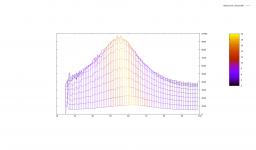Two more view from the same graph, maybe it's more simple to see.
On the second one you can see how the amplifier was struggling to provide the current (it doesn't affect the measure though, I just measured the behaviour of the speaker).
On the second one you can see how the amplifier was struggling to provide the current (it doesn't affect the measure though, I just measured the behaviour of the speaker).
Attachments
I suppose a half-round rubber surround is not likely to be linear. when active or heated or worn. Better chance that the old time large accordion surrounds are more linear. Long ago, the cone paper formed the surround, with the large accordion spider providing restoring force. Paper linear? Might just be.
But the harm must be higher for subs and for subs in enclosures tuned to the driver (which I would never use). Shifting Fo of little importance for sealed boxes. Mid drivers do not stress their suspensions like subs and certainly do not have Fo within their band.
But the non-linearity of stressed surrounds has to show up as harmonic distortion, even if hard to notice hidden in the big distortion of cone subs.
B.
But the harm must be higher for subs and for subs in enclosures tuned to the driver (which I would never use). Shifting Fo of little importance for sealed boxes. Mid drivers do not stress their suspensions like subs and certainly do not have Fo within their band.
But the non-linearity of stressed surrounds has to show up as harmonic distortion, even if hard to notice hidden in the big distortion of cone subs.
B.
Last edited:
You're right, I think I'll just ignore the discordant results and go on with the theory 😛
The result will be very ok, and the room has way more impact than some few Hz on the resonance frequency.
But, I guess for finely tuned bass reflex, that kind of things might cause some problems.
The result will be very ok, and the room has way more impact than some few Hz on the resonance frequency.
But, I guess for finely tuned bass reflex, that kind of things might cause some problems.
What was the resistor value? Assuming the resistor was tiny from what you said and the roughness of the plots, these results don't surprise me:with 1000mV, fs is about 60Hz.
With 8000mV, fs is 55Hz (theoretical value is 51.6Hz)
- 8V across the speaker is no way small signal. It is out of the bounds of the theory. That's why LEAP developed large signal models for simulation, and why Klippel measures nonlinear parameters.
- Even 1V is maybe not "small signal"
- Fs will change with drive level. If I recall correctly, Dick Small's original thesis actually has a section about that. Offhand I might have expected it to go up and for instance the spider stretches harder, but there can be other electromechanical effects (air trapped under the dust cap...though seems that would make resonance increase as well...)
- And yes, Thiele/Small/Benson's equating of physical parameters into filter theory is just a 1st level approximation. A quite good one for normal listening levels, but goes awry at higher levels. Rather like Newton versus Einstein.
What was the resistor value?
- 8V across the speaker is no way small signal. It is out of the bounds of the theory. That's why LEAP developed large signal models for simulation, and why Klippel measures nonlinear parameters.
[...]
- And yes, Thiele/Small/Benson's equating of physical parameters into filter theory is just a 1st level approximation. A quite good one for normal listening levels, but goes awry at higher levels. Rather like Newton versus Einstein.
It was a 10 ohm resistor, but it doesn't affect anything as it is just used to measure the current.
If the speaker was diverging from theory more and more as I push the volume I wouldn't be surprised. What really trouble me here is that at small signal I am way off the T&S parameters given by the manufacturer. I need a significantly higher signal to find the theoretical values.
I see two possible explanation :
1) my speaker is faulty somehow
2) the manufacturer measured the T&S parameters at a rather high voltage, and the speaker isn't very linear with small extrusions.
It really depends, I looked from a range to few mV to some few volts. With bigger value resistor I wont be able to have some few volts on the speaker (I dont have an amplifier powerful enough).
You want to use a resistance based on max output voltage for 'sharpest' readings and since I was rarely using the same source used a big pot to dial it in.

